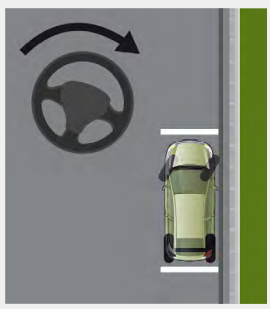Section 5: Learning to Drive
1/76
There's no tags or description
Looks like no tags are added yet.
Name | Mastery | Learn | Test | Matching | Spaced |
|---|
No study sessions yet.
77 Terms
to start the engine
place right foot on the brake pedal and check the gear selector for park. Insert the key into the ignition and turn/ push the start button
to move the vehicle
move the gear selector to "D" (drive). Check forward for a safe path and for traffic to the sides and behind. signal, and if safe, move your foot off the brake and to the accelerator and press gently. accelerate gradually and smoothly with the ball of your foot on the pedal and the heel of your foot on the floor
to stop the vehicle
check mirrors for traffic to the rear of the vehicle. move foot from the accelerator to the brake pedal. press with steady pressure unitl your vehicle comes to a stop
the distance it takes to bring a vehicle to a complete stop depends on
driver's reaction time
speed at which the vehicle is traveling
the condition of the vehicles brakes
the condition of the pavement (wet, dry, icy, salted, gravel, etc.)
allow a following distance of the vehicle ahead of you
3-4 second
behind a stop line or crosswalk at any stop sign or red traffic signal before entering an intersection
a driver must stop
behind the stop line or crosswalk at any red traffic signal where right or left turns on red are permitted. the driver may only proceed with a legal turn on red after coming to a full stop and yielding the right of way to all crossing traffic and to all pedestrians crossing the intersection
a driver must stop
at a flashing red traffic signal, yielding to all traffic that does not stop
a driver must stop
at a sidewalk, or if there is no sidewalk, at a point prior to entering the roadway, when emerging from an alley, driveway, or private road in a business or residential district.
a driver must stop
driver's must __ to any pedestrian on the sidewalk
yield the right of way
before entering an intersection if there is not sufficient space on the other side to accommodate the vehicle. the law applies whether or not a traffic signal gives a driver the right to proceed
a driver must stop
at the approach of a public safety vehicle (police cars, fire engine, ambulance) displaying flashing lights and sounding a warning signal, a driver must
move as far as possible to the right of the Road and remain there until the emergency vehicle has passed
when do you not move to the right and stay there while an emergency vehicle passes
when the vehicle is traveling in the opposite direction on a divided highway
turn the steering wheel
in the direction you want the vehicle to move, whether moving forward or in reverse
place hands where on the steering wheel in order to maintain control of the vehicle and avoid air bags
4 and 8 o'clock positions
your grip on the steering wheel should be
firm but gentle
before backing up vehicle
check the behind of vehicle for children and small objects
place foot on the brake and shift to reverse
grasp steering wheel at 12 o'clock position with left hand and place right arm on the back of the passenger seat and look directly through the rear view windows
use mirrors for backing up but keep in mind that these mirrors do not show the area immediately behind your vehicle
utilize backup and rear view cameras if applicable, but dont rely on these solely as they dont show the whole area
accelerate gently and smoothly, keeping speed slow.
steer slightly in the direction the rear of the vehicle should move
if backing up while turning, make quick checks to the front and sides. continue looking to the rear until coming to a complete stop
at all intersections, reduce your speed and search for
Traffic control devices, oncoming and cross traffic (including motorcycles and bicylists - l9ok left, right then left again), pedestrians and bicyclists, the roadway condition, and areas of limited visibility
when turning
signal your intentions,
search all corners for traffic controls, pedestrians, other vehicles and so on,
enter and maintain proper position in the lane that is closest to the direction you want to go,
look through the turn to the farthest point possible along the intended path,
accelerate smoothly to appropriate speed, make sure your turn signal is canceled and check traffic to the rear
a turn signal must be given at least __ before the intended turn
100 feet
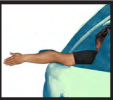
hand and arm signal left turn

hand and arm signal right turn

hand and arm signal slow/ stop (if brake lights are not functioning properly)
right turns
avoid swinging wide to the left before making the turn
always turn right from the right-most portion of your lane into the right-most portion of the street your turning into
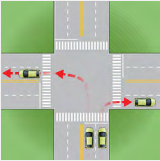

mechanical turn signal
left turns
when making a left turn, yield to traffic
always turn left from the left most portion of your lane into the lane furthest left, just to the right of the center dividing line of the street you're turning onto.
this pertains to four-lane highways
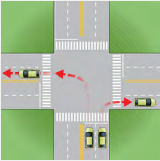
multiple lane turning
Identify and enter the lane from which you will turn and stay in that lane until the turn is completed.
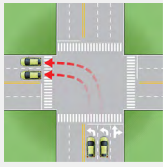
right turn on red
you may turn right at a red traffic signal, unless a sign prohibits it.
when making a right turn on red, come to a complete stop and allow all crossing traffic and all pedestrians to clear the intersection before you proceed
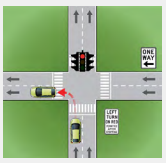
Left turn on red
you may turn left at a red traffic signal only from extreme left lane of a one-way street onto another one-way street, unless the intersection has a sign prohibiting a left turn on red
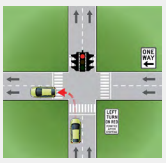
at a traffic signal when a light turns green
pause before moving into the intersection. do not rely on other road users to obey traffic signals or signs, as they may not yield the right-of-way
when you encounter a situation where you have a green light, but traffic fills the roadway across the intersection
stop prior to the intersection and wait until traffic across the intersection moves forward. do not move into the intersection and stop. do not block traffic in the intersection
when turning on a road
take time to make sure the path of travel is clear and there is no crossing traffic. you need a large enough gap to get your vehicle across the roadway. you need enough space to turn into the appropriate lane and get up to speed.
if an approaching vehicle has on its turn signal
do not pull out or turn in front of that vehicle without assured proper distance. do not assume the vehicle is turning. the driver may turn after passing your vehicle or may have forgotten to turn off their signal
when stopped at a stop sign where you cannot see crossing traffic
edge forward to check for traffic before entering the intersection
a roundabout (or traffic circle) is
a circular intersection with design features that promote safe and efficient traffic flow
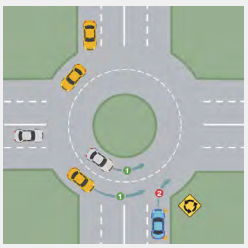
vehicles travel counter clockwise around a raised center island, with entering traffic yield the right of way to circulating traffic
roundabout/traffic circles
upon entering a roundabout
check for signs regarding your travel direction. you cannot change lanes once you are in the roundabout.
when entering a roundabout
slow down to enter, enter in a counterclockwise direction, yield to the traffic already in the roundabout or traffic circle, look to the left for traffic and enter when the lane is clear, once in the roundabout, keep moving. do not stop or change lanes
to exit a roundabout,
turn on signal, use the 1st exit to turn right, 2nd exit to go straight, 3rd exit to turn left, 4th exit to make a u-turn
drive on the right half of the roadway, except when
overtaking and passing another vehicle proceeding in the same direction
driving on a road divided into three or more marked lanes
driving on a road designed and posted for one-way traffic
otherwise directed by a police officer or traffic control device
an obstruction makes it necessary for you to drive left of center. yield right of way to oncoming traffic.
when driving on a road with four or more lanes
drive in the right lane. use the left lane just right of center to pass and make left turns
when changing lanes, ensure safety by
check your mirrors and blind spots by turning your head and looking over your shoulder in the direction you plan to move.
identify a gap in traffic, signal, and look again in the direction of the lane change
adjust your speed and steering into the lane
cancel your turn signal
to enter a multilane highway/freeway
beware of the vehicle ahead, look over your shoulder in the direction you are merging, and use your outside mirrors to identify a gap in traffic
signal and use the acceleration lane to reach the speed of other vehicles to merge with the traffic flow
make sure to cancel your turn signal

when exiting a roadway
plan to move to the lane closest to your exiting point early enough to avoid a quick lane change
maintain your vehicle speed as long as you are on the main roadway
signal your intention, move to the deceleration lane and slow your exiting speed
check the posted speed for the deceleration lane

if you miss your exit
take the next one.
do not use the opening through the median, which is only to be used for emergency and public safety vehicles
how to pass
check for oncoming traffic.
check your mirrors and over your shoulder for following or passing vehicles
signal your intentions when it is safe to pass
steer smoothly into the passing lane
maintain or adjust speed as necessary
continue to pass until both headlights of the passed vehicle are visible in the rear-view mirror
signal your intention to return to the lane
steer smoothly into the lane, maintaining or adjusting speed as appropriate

when being passed
stay in your lane
maintain a constant speed to allow the driver to pass you
do not attempt to pass when
an oncoming vehicle is approaching
your view is blocked by a curve or hill
at intersections
before a highway/railroad crossing or bridge
passing is permitted when
safe to do so
multi-lane, two-way roadway: on multi-lane roads, the is intended to be used for passing slower vehicles when the pass can be completed without interfering with traffic in either direction. never pass on the ___, whether it is paved or not
left-most lane; shoulder
on a two-lane two-way roadway, is prohibited from both directions when there is a in the center of the road
passing; solid double yellow line
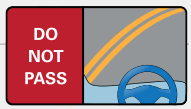
on a two-lane, two-way road way, crossing the solid double yellow line is permitted only to
turn left onto driveways or pass a slow-moving vehicle (e.g. bicycle or vehicle displaying slow-moving sign) when safe to do so
passing zone on two-lane, two-way roadway: passing is prohibited when the is in your lane. you can only pass when the ___ is in your lane
solid yellow line; broken yellow line

center two-way left turn lane: the two-way left turn lane in the center of a multi-lane, two-way roadway is reserved only for
left-turning vehicles in either direction. special signs and pavement marking arrows are used. this lane is not used for passing, merging into traffic or traveling


indicates a highway-railroad crossing.

indicates a highway-railroad crossing
some railroad crossings are marked with
train-activating flashing red lights, with or without a gate. these signs caution you to slow down and be prepared to stop upon seeing or hearing a train
stop no closer than __ from the crossing when a train is approaching. wait until the train has passed and any warning signals have stopped before crossing the tracks
15 feet
when the crossing is marked with only pavement markings or crossbuck signs
slow down and be prepared to stop if you see or hear a train coming. do not stop on the tracks and do not attempt to cross the tracks when a train is approaching.
if the railroad crossing is marked with a stop sign
all vehicles must stop before proceeding
operators of motor vehicles carrying passengers for hire, school buses, or vehicles carrying explosive or flammable liquids are
required to stop at railroad crossings. the drivers listen through an open door or window, look in both ways for an approaching train, and for signals indicating the approach of a train, and then proceed with care
a driver must stop for a school bus when
the school bus is dropping off or picking up students.
when a school bus driver is preparing to stop the bus,
he or she activates four amber (yellow) warning lights, two on the front two on the back. the warning lights continue to flash until the bus is fully stopped.
_ are not required to stop during the amber flashing lights of a school bus, but should prepare to stop as soon as the bus comes to a full stop
other vehicles
when the bus comes to a complete stop,
the amber lights stop flashing and four red lights- two in the front two in the back - start flashing while the children enter or leave the bus. a stop arm may extend but you still have to stop even if this doesn't happen
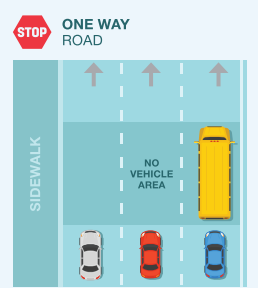
if the bus is stopped on a street or a road with fewer than four lanes
all traffic approaching the bus from either direction must stop at least 10 feet from the front or rear of the bus and remain stopped until the bus begins to move or the bus driver signals motorists to proceed
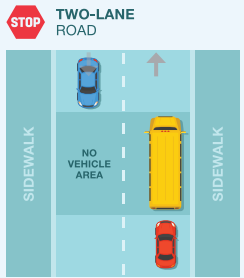
if the bus is stopped on a street or road with for or more lanes
only traffic proceeding in the same direction as the bus must stop at the rear of the bus and remain stopped until the bus begins to move
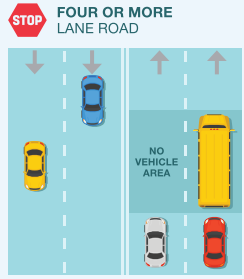
always park in a
designated area

vehicles may be parked
facing the direction of the traffic on that side of the street, parallel to and not more than 12 inches from the right curb
on one way streets, vehicles may be parked
parallel to and not more than 12 inches from the right or left curb
angled parking is
marked with lines
check for signs or painted curbs that may
prohibit or limit parking

some parking restrictions are indicated by
colored curb markings
do not park in spaces marked by
a wheelchair symbol reserved for people with disabilities, unless you have a tag
no person shall stop, park, or stand a vehicle in any of the following places, except when necessary to avoid conflict with other traffic, or in compliance with the directions of a law enforcement officer or traffic control device
-on a sidewalk
-in front of a public or private driveway
-in or within 20 feet of an intersection or crosswalk
-within 10 feet of a fire hydrant
-within one foot of another parked vehicle
-alongside a vehicle stopped or parked at the edge or curb of a street
-at any place where signs prohibit stopping
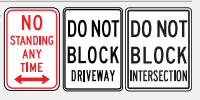
a bicycle, electric bike, moped, motor scooter (150 cc or less), or micro-mobility device may be parked on the sidewalk provided it does not
impede the normal flow of pedestrian traffic
in the event you must park your vehicle on a hill or graded surface,
turn the front wheels toward the curbside of the road to stabilize the vehicle, shift from "DRIVE" gear to "PARK" gear, set the parking brake, and turn engine off
